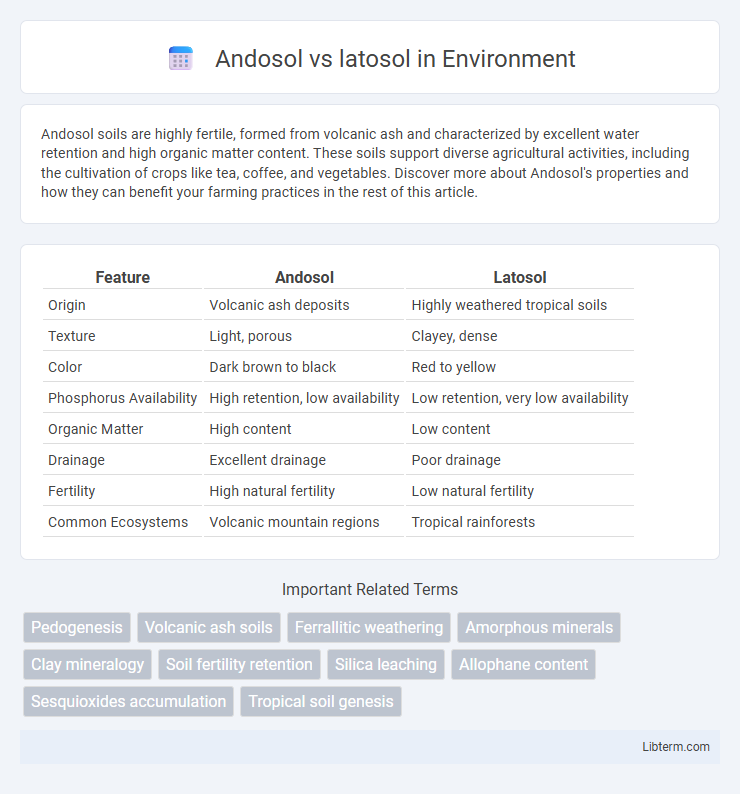Andosol soils are highly fertile, formed from volcanic ash and characterized by excellent water retention and high organic matter content. These soils support diverse agricultural activities, including the cultivation of crops like tea, coffee, and vegetables. Discover more about Andosol's properties and how they can benefit your farming practices in the rest of this article.
Table of Comparison
| Feature | Andosol | Latosol |
|---|---|---|
| Origin | Volcanic ash deposits | Highly weathered tropical soils |
| Texture | Light, porous | Clayey, dense |
| Color | Dark brown to black | Red to yellow |
| Phosphorus Availability | High retention, low availability | Low retention, very low availability |
| Organic Matter | High content | Low content |
| Drainage | Excellent drainage | Poor drainage |
| Fertility | High natural fertility | Low natural fertility |
| Common Ecosystems | Volcanic mountain regions | Tropical rainforests |
Introduction to Andosols and Latosols
Andosols are volcanic soils characterized by high organic matter content, excellent water retention, and formation from volcanic ash, predominantly found in regions with active or recent volcanic activity. Latosols, also known as Oxisols, are deeply weathered tropical soils rich in iron and aluminum oxides, exhibiting low fertility due to intense leaching and nutrient depletion. Both soil types play crucial roles in agriculture and ecosystem functioning but differ markedly in origin, mineral composition, and nutrient availability.
Formation Processes of Andosols
Andosols form primarily from volcanic ash and tephra deposits, characterized by rapid weathering and the accumulation of allophane and imogolite minerals. These soils develop through intense volcanic activity, organic matter incorporation, and high moisture conditions, promoting high porosity and fertility. In contrast, Latosols arise from deep weathering in tropical climates, dominated by iron and aluminum oxides and exhibiting lower nutrient retention.
Formation Processes of Latosols
Latosols form predominantly in tropical regions through intense weathering and leaching of parent rock material, resulting in deep, well-drained soils rich in iron and aluminum oxides. Unlike Andosols, which develop from volcanic ash with high organic matter and unique mineralogy, latosols undergo prolonged chemical weathering under humid conditions leading to nutrient-poor, highly oxidized soils. The formation of latosols involves the dissolution of primary minerals and accumulation of sesquioxides, contributing to their characteristic red or yellow coloration and acidic pH.
Key Characteristics of Andosols
Andosols are volcanic soils characterized by high organic matter content, excellent nutrient retention, and a porous, friable texture that promotes good water drainage and aeration. Unlike Latosols, which are highly weathered tropical soils rich in iron and aluminum oxides with low fertility, Andosols typically exhibit higher fertility due to their mineralogy and ability to retain phosphorus. These properties make Andosols ideal for agriculture in volcanic regions, supporting diverse crops with minimal soil amendments.
Key Characteristics of Latosols
Latosols are highly weathered tropical soils characterized by a deep red or yellow color due to the presence of iron and aluminum oxides, exhibiting low natural fertility and strong acidity. These soils have a well-developed, stable structure with low cation exchange capacity and limited nutrient retention compared to Andosols, which are younger volcanic soils rich in organic matter and exceptionally fertile. Latosols form predominantly in humid tropical regions with intense leaching, resulting in thick, well-drained profiles but requiring significant soil management for productive agriculture.
Nutrient Availability: Andosols vs Latosols
Andosols exhibit high nutrient availability due to their volcanic ash origin, rich in minerals like phosphorus and potassium, supporting fertile soil conditions ideal for agriculture. In contrast, Latosols are typically highly weathered tropical soils with low nutrient retention, especially deficient in phosphorus, due to intense leaching and aluminum saturation. Effective soil management in these environments often involves targeted fertilization and organic matter additions to enhance fertility in Latosols, whereas Andosols generally require less intensive nutrient supplementation.
Agricultural Suitability Comparison
Andosols, rich in volcanic ash and high organic matter, exhibit excellent water retention and nutrient availability, making them highly suitable for cultivating crops like vegetables, coffee, and fruit trees. Latosols, characterized by intense weathering and low nutrient content, often require lime and fertilizer amendments to support crops such as sugarcane and oil palm in tropical regions. The contrasting physical and chemical properties directly influence their agricultural productivity and management practices.
Distribution and Global Occurrence
Andosols are predominantly found in volcanic regions such as the Pacific Ring of Fire, with significant occurrences in countries like Japan, Indonesia, and parts of the western United States. Latosols, also known as Oxisols, are extensive in tropical rainforest zones of the Amazon Basin, Central Africa, and Southeast Asia, characterized by deep weathering and intense leaching. The global distribution of Andosol is limited to young volcanic landscapes, whereas Latosol dominates ancient, stable tropical surfaces with high rainfall and temperature.
Environmental Challenges and Management
Andosol soils, rich in volcanic ash and organic matter, exhibit high water retention but are vulnerable to erosion and nutrient leaching under deforestation and intensive agriculture. Latosol soils, prevalent in tropical regions, face challenges such as acidification and nutrient depletion due to heavy rainfall and continuous farming without adequate replenishment. Effective management involves adopting conservation practices, organic amendments, and sustainable land use to maintain soil fertility and prevent degradation in both Andosol and Latosol environments.
Summary: Choosing Between Andosol and Latosol
Andosols, characterized by high organic matter and volcanic ash content, offer excellent water retention and fertility, making them ideal for agriculture in cooler, humid regions. Latosols, rich in iron and aluminum oxides with intense weathering and leaching, dominate tropical climates and require specific management to maintain productivity due to nutrient deficiencies. Selecting between Andosol and Latosol depends on climate compatibility, soil fertility needs, and crop type considerations to optimize agricultural outcomes.
Andosol Infographic

 libterm.com
libterm.com